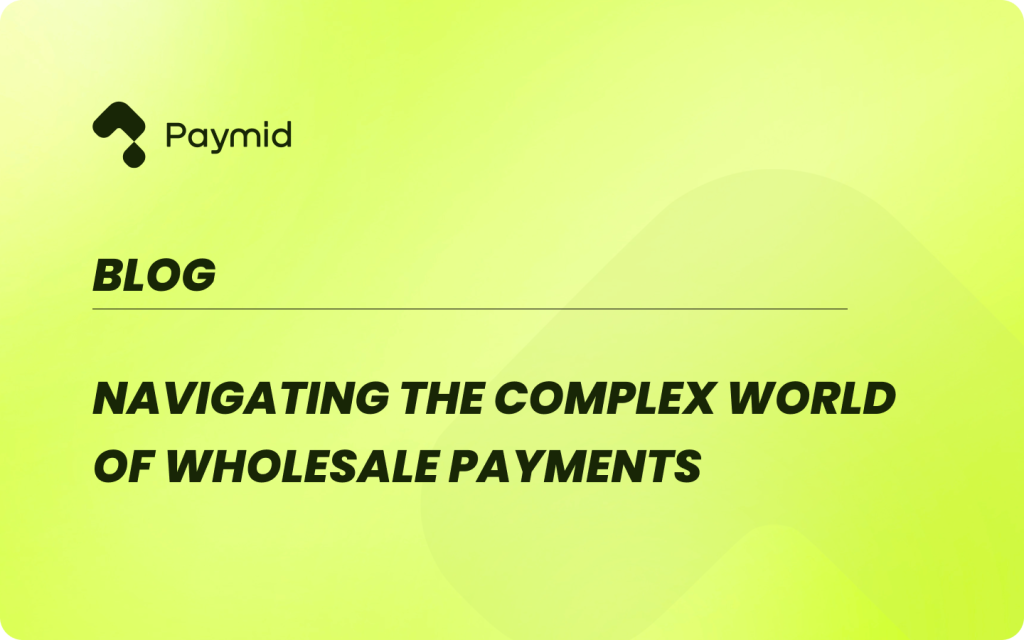How to Navigate the Complex World of Wholesale Payments

Wholesale payments move trillions of dollars between financial institutions every day, forming the backbone of the modern financial system. These high-value transactions demand precise execution, robust security measures, and strict compliance protocols to maintain the stability of global markets. Financial institutions must understand and effectively manage these complex payment processes to ensure seamless operations.
The current global financial landscape presents numerous challenges for organizations handling wholesale payments. From central banks and clearing house automated payment systems to specialized high-value clearing mechanisms, multiple components work together to facilitate these crucial transactions.
Read More: The financial sector relies heavily on sophisticated payment mechanisms to process large-value transactions between institutions. Wholesale payment systems represent specialized infrastructure designed to handle high-priority, typically large-value transfers between financial institutions, either for their accounts or on behalf of their customers[1]. Wholesale payment systems are characterized by several distinctive features: In the contemporary financial ecosystem, wholesale payments constitute a critical component of global economic stability. The market generates approximately $490 billion in global revenues, with traditional banks maintaining a dominant 95% share[2]. This sector is projected to grow at a 6% annual rate, reaching $645 billion by 2027, highlighting its expanding significance in international finance[3]. While retail payment systems handle everyday consumer transactions, wholesale systems operate on a fundamentally different scale and principle. The primary distinctions lie in settlement speed and transaction values. Wholesale systems typically process immediate, high-value transfers through Real-Time Gross Settlement (RTGS) or Deferred Net Settlement (DNS) mechanisms, whereas retail systems traditionally handle smaller transactions with longer settlement timeframes[4]. The evolution of wholesale payment infrastructure has been driven by technological advancement and risk mitigation requirements. Modern systems emphasize immediate settlement finality, reduced credit risk, and enhanced liquidity management capabilities. This transformation has been particularly evident in the adoption of RTGS systems, which eliminate settlement risk by processing payments individually and immediately, though at the cost of higher liquidity requirements. The infrastructure supporting wholesale payment systems comprises three critical components that work in concert to ensure secure and efficient high-value transfers between financial institutions. Central banks serve as the cornerstone of wholesale payment infrastructure, acting as both operators and overseers. Their fundamental responsibilities include: Payment messaging networks form the communication backbone of wholesale payment infrastructure, enabling secure transmission of payment instructions between participating institutions[5]. These systems process administrative messages and transfer instructions, creating a standardized communication framework for high-value clearing systems. The messaging infrastructure ensures real-time visibility across the entire wholesale payments ecosystem while maintaining strict security protocols. Two primary settlement mechanisms dominate the wholesale payments landscape: Real-Time Gross Settlement (RTGS) and Deferred Net Settlement (DNS) systems. RTGS systems have become the global standard since their emergence in the 1980s, processing payments immediately on a one-by-one basis. This approach eliminates settlement risk as payments are final and irrevocable upon completion[6]. In contrast, DNS systems accumulate payments throughout the business day, calculating multilateral net positions at predetermined intervals. While DNS requires less liquidity than RTGS, it introduces potential settlement risk due to the delay between transaction and settlement. The evolution from DNS to RTGS systems reflects the growing emphasis on risk mitigation in wholesale payment infrastructure, particularly in response to increasing transaction values and volumes[7]. The adoption of RTGS systems has been driven by technological advances and regulatory requirements, with central banks worldwide implementing these systems to enhance financial stability. This shift has been particularly notable in emerging market economies, where the availability of off-the-shelf RTGS solutions has facilitated rapid modernization of payment infrastructure[8]. Managing large-value financial transfers presents significant operational challenges that require sophisticated solutions and robust control mechanisms. Financial institutions must navigate complex requirements while maintaining efficient payment operations. Effective liquidity management stands as a cornerstone of wholesale payment operations[9]. Organizations must maintain adequate cash positions to meet immediate and short-term obligations while optimizing returns on idle funds. Real-time visibility into transactions has become crucial, as it enables: The challenge lies in striking the perfect balance between maintaining sufficient liquidity for operations and maximizing investment returns. Too little cash creates illiquidity risks, while excess reserves reduce profitability potential. In today’s interconnected financial landscape, sophisticated risk management approaches are essential. Financial institutions must implement comprehensive controls to address potential threats, particularly in high-value payment processing. Key risk factors include: Real-time reconciliation of inbound and outbound payments has emerged as a critical tool for risk management, enabling institutions to monitor counterparty obligations and manage payment releases effectively[10]. The regulatory landscape for wholesale payments continues to evolve, requiring institutions to maintain robust compliance frameworks. Non-compliance consequences can be severe, including substantial financial penalties ranging from $5,000 to $100,000 per month. Organizations must adhere to multiple regulatory standards: Core Requirements: Financial institutions must regularly update their compliance protocols to address new regulations while maintaining operational efficiency. This includes implementing sophisticated monitoring systems and maintaining comprehensive audit trails for all payment activities. In today’s rapidly evolving financial landscape, successful wholesale payment operations depend on implementing comprehensive technological solutions and maintaining robust security protocols[11]. Financial institutions must adopt a multi-faceted approach to ensure efficient, secure, and compliant payment processing. Organizations must deploy sophisticated monitoring solutions that provide real-time visibility into payment flows. Advanced monitoring systems should incorporate: These systems enable institutions to identify potential issues before they escalate into significant problems, ensuring the smooth operation of wholesale payment processes[12]. Digital transformation has become paramount in wholesale payment operations. Modern payment infrastructure requires continuous technological advancement to maintain a competitive advantage. Financial institutions are increasingly focusing on automation and digital capabilities to enhance efficiency and reduce operational costs. The implementation of orchestration engines helps manage and unify payments from diverse sources, while API integration enables seamless connectivity with various payment platforms[13]. Organizations are also investing in artificial intelligence and machine learning capabilities to automate routine tasks and improve decision-making processes. Security remains a critical concern in wholesale payment operations, with 71% of businesses reporting payment fraud attempts in 2021[14]. Comprehensive security frameworks must incorporate multiple layers of protection, including encryption protocols, tokenization, and multi-factor authentication. Essential security components include endpoint security measures, which encompass hardware protection, software safeguards, and physical access controls. Financial institutions must also maintain strict compliance with industry standards such as PCI DSS while implementing regular security updates and patches to protect against emerging threats. The integration of advanced fraud detection systems helps identify and prevent unauthorized transactions by monitoring patterns and behavioral anomalies. These systems work in conjunction with firewall and network security measures to create a robust defense against external threats and maintain the integrity of payment infrastructure[15]. Modern wholesale payment systems stand as fundamental pillars of global financial stability, demanding sophisticated management approaches and robust technological solutions. Financial institutions must master complex settlement mechanisms while maintaining strict security protocols and regulatory compliance. Success requires a delicate balance between operational efficiency and risk management, supported by advanced monitoring systems and real-time processing capabilities. The future of wholesale payments points toward increased automation, enhanced security measures, and more sophisticated risk management tools. Organizations that embrace technological advancement while maintaining strict operational controls will excel in this evolving environment. Financial institutions must remain vigilant in updating their systems, strengthening security frameworks, and adapting to new regulatory requirements as payment volumes and values continue to grow.
Understanding Wholesale Payment Systems
Importance In The Global Financial Landscape
Comparison With Retail Payment Systems
Key Components of Wholesale Payment Infrastructure
Central Banks and Their Role
Payment Messaging Systems
Settlement Mechanisms (RTGS and DNS)
Navigating Challenges in Wholesale Payments
Liquidity Management
Risk Mitigation Strategies
Regulatory Compliance
Best Practices for Efficient Wholesale Payment Operations
Implementing Robust Monitoring Systems
Leveraging Technology For Process Optimization
Enhancing Security Measures
What Does the Future Hold for Wholesale Payments?
References
[1] – IR – The Role of Wholesale Payments in the Global Financial Landscape. https://www.ir.com/blog/payments/the-role-of-wholesale-payments-in-the-global-financial-landscape
https://www.elibrary.imf.org/view/book/9781557753861/ch07.xml [11] – IR – Managing Online Payment Risks. https://www.ir.com/guides/managing-online-payment-risks [12] – Monday – Risk Mitigation. https://monday.com/blog/project-management/risk-mitigation/ [13] – HighRadius – Strategies Involved in Credit Risk Management. https://www.highradius.com/resources/Blog/strategies-involved-in-credit-risk-management/ [14] – JP Morgan – Payments Fraud and Control https://www.jpmorgan.com/content/dam/jpm/commercial-banking/insights/cybersecurity/highlights-afp-2022-payments-fraud-and-control-report.pdf [15] – European Payments Council – Payments Treats and Fraud. https://www.europeanpaymentscouncil.eu/sites/default/files/kb/file/2023-12/EPC181-23%20v1.0%202023%20Payments%20Threats%20and%20Fraud%20Trends%20Report.pdf

